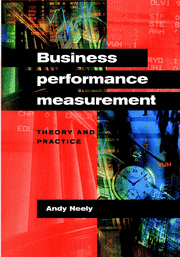Book contents
- Frontmatter
- Contents
- List of contributors
- Preface
- Part I Performance measurement – functional analyses
- Part II Performance measurement – theoretical foundations
- Part III Performance measurement – frameworks and methodologies
- Part IV Performance measurement – practical applications
- 13 What really goes on in the name of benchmarking?
- 14 Measuring marketing performance: Which way is up?
- 15 Loosely coupled performance measurement systems
- 16 Redefining government performance
- Part V Performance measurement – specific measures
- Part VI Performance measurement – emerging issues and trends
- Index
15 - Loosely coupled performance measurement systems
from Part IV - Performance measurement – practical applications
Published online by Cambridge University Press: 06 July 2010
- Frontmatter
- Contents
- List of contributors
- Preface
- Part I Performance measurement – functional analyses
- Part II Performance measurement – theoretical foundations
- Part III Performance measurement – frameworks and methodologies
- Part IV Performance measurement – practical applications
- 13 What really goes on in the name of benchmarking?
- 14 Measuring marketing performance: Which way is up?
- 15 Loosely coupled performance measurement systems
- 16 Redefining government performance
- Part V Performance measurement – specific measures
- Part VI Performance measurement – emerging issues and trends
- Index
Summary
Introduction
This chapter reports on the loosely coupled performance measurement practices of a high-performing restaurant chain. Over a period of four years we observed a series of initiatives aimed at “tightening up” the performance measurement systems of the case company. Yet none of these initiatives resolved the desire for what the finance director towards the end of the research period called “unambiguous performance information.” Head office managers of all grades continued to demand performance measurement systems that allowed more comprehensive and detailed control over the operational decisions of restaurant managers. Whilst it was easy to see in principle how such systems could have been implemented, successive working parties did not impose them. This was not for lack of market competition, and it did not result in lower performance. Indeed, managers felt competitive pressures intensified during the research period and still managed to both increase market share and profitability of the case company. What we were faced with was a high-performing company in a competitive industry that espoused to rectify the flaws of its performance measurement system, yet did not. We think that this case holds a lesson for those who are interested in performance measurement system implementation, because it combines high performance with a handling of performance measurement issues that would seem to violate an implicit cornerstone of much of the performance measurement literature. We hypothesize that managers’ “failure” to address the obvious shortcomings of their performance measurement systems may have been related to the management style that enabled the company to perform so remarkably well.
- Type
- Chapter
- Information
- Business Performance MeasurementTheory and Practice, pp. 244 - 258Publisher: Cambridge University PressPrint publication year: 2002
- 1
- Cited by



